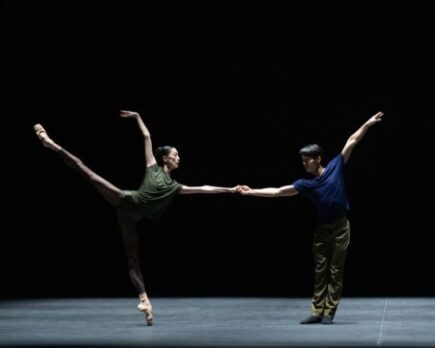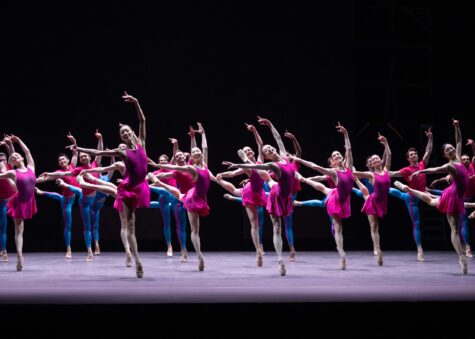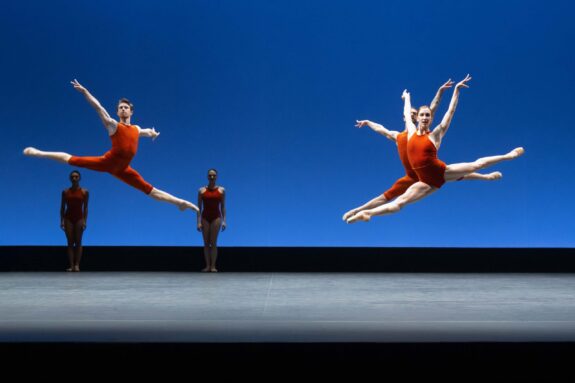 United Kingdom English National Ballet’s The Forsythe Programme: Dancers of English National Ballet. Sadler’s Wells, London, 10.4.2025. (JO’D)
United Kingdom English National Ballet’s The Forsythe Programme: Dancers of English National Ballet. Sadler’s Wells, London, 10.4.2025. (JO’D)

Rearray (London Edition 2025)
Choreography – William Forsythe
Costume design – Dorothee Merg
Music – David Morrow
Lighting design – Tanja Rühl
Dancers – Sangeun Lee, Henry Dowden, Rentaro Nakaaki
Herman Schmerman (Quintet)
Choreography and Costume design – William Forsythe
Music – Thom Willems
Lighting design – Tanja Rühl
Dancers – Aitor Arrieta, Alice Bellini, Ivana Bueno, Francesco Gabriele Frola, Swanice Luong
Playlist (EP)
Choreography and Costume design – William Forsythe
Music – Peven Everett, ABRA, Khalid, Barry White, Natalie Cole
Lighting design – Tanja Rühl
Dancers – Aitor Arrieta, Henry Dowden, Noam Durand, Shunhei Fuchiyama, Giorgio Garrett, Gareth Haw, Nathaniel Ritter-Magot, Ken Saruhashi, Thiago Silva, Eric Snyder, Erik Woolhouse, Rhys Antoni Yeomans, Junor Souza, Shiori Kase, Anri Segura, Emily Suzuki, Alice Bellini, Georgia Bould, Ivana Bueno, Swanice Luong, Precious Adams, Haruhi Otani, Artists of the Compnay
Starting with the muted colours and intimacy of Rearray (London Edition 2025), ending with the bright blues and pinks of the large-scale, joyous Playlist (EP), English National Ballet’s The Forsythe Programme presents work by choreographer William Forsythe from three stages of his career.
The original Rearray was created for Sylvie Guillem and Nicolas Le Riche in 2011. Here, it is a work for two men and a woman; a work in which nothing can be taken for granted. Not movement: it opens with the pointe-shoed female dancer, Sangeun Lee, in static profile on the stage. Not the recorded music by David Morrow: at times the dancers move to silence, or to the sound of their own breath. Not lighting: there are moments when the stage is suddenly plunged into darkness.
The costumes cover the dancers’ legs and torsos, leaving only their arms bare. The piece becomes a study in upper limbs catching the light as they sweep, bend and link against a black backdrop. The whipcord arms of Sangeun Lee suit this choreography well. And when, towards the end, she rises on pointe, centre-stage, Henry Dowden and Rentaro Nakaaki sit either side of her: attendants whose arms move softly as if in silent homage.
The origins of Herman Schmerman (Quintet), the work that follows, go back to 1992. The choreographer’s second commission for New York City Ballet, with conditions that its five dancers wear leotard costumes and perform on a bare stage. The leotards (calf-length body suits for the two male dancers) are of what looks like orange-red velvet. In brighter light, against a backdrop of pale blue, the dancers move with speed and force to Thom Willems’s electronic score. Lower and upper limbs are both very much in play.
Balanchine is there in the flexed hands and ‘neo-classical’ steps. William Forsythe adds his own overlapping configurations, his exits and entrances (the ‘Forsythe strut’), his increased speed, his surprise ending. On this opening night, though, it seems there should be more force, more speed. Did something go wrong at the start? Is that why someone in the stalls let out a loud laugh? For whatever reason, it is not until Aitor Arrieta performs his solo halfway through (and perhaps only then), that the piece really comes to life.

The curtain went up on Playlist (EP) as people were still finding their seats after the interval. This did not matter. A thrill ran through the cheering audience at the sight of twelve, male, dancer-athletes, dancer-jocks, in pink and blue, waiting to begin their dance. This section of the piece was created on the men of English National Ballet in 2018. It belongs to them. It belongs to Sadler’s Wells. ‘I am a native ballet speaker,’ William Forsythe told dance writer Sarah Compton in an interview that year. To Peven Everett’s Surely Shorty these men may hunker, like athletes, but they also execute shunt hops in arabesque.
In subsequent sections Playlist (EP) showcases the men and women of the company at their exuberant best: Shiori Kase (holding a position for a second or two longer than you might expect); Francesco Gabriele Frola (his pirouette); Ivana Bueno (finding the power and certainty that seemed to elude her in the second work of the evening). But when everyone is on stage in the penultimate section – men, women, principals, artists – there is a kind of poignancy, too. As the recording of Barry White’s Sha La La Means I Love You comes to an end, the dancers start to walk slowly on demi-pointe, arms en couronne. They are still walking, each on their own trajectory, as the lights fade.
John O’Dwyer
Featured Image: English National Ballet dancers performing William Forsythe’s Herman Schmerman © Photography by ASH
